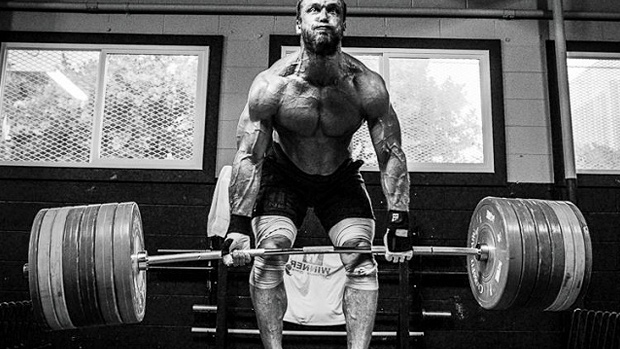Just the Facts
Fact #1: Forcing your body to build muscle requires progressively more physical stress.
Fact #2: Your body has a limited capacity to tolerate, respond to, and adapt to stress.
These two things remain undeniable. If you want to build huge muscles, you must continually challenge them by placing a greater demand upon them. If you stick with the same stress level month after month, you'll quickly reach a point where your body is used to the stress and won't need to adapt (i.e. grow) anymore.
So, the serious gym rat must gradually place a greater demand upon his muscles. Initially this can be done simply by adding weight to the bar, moving on to more advanced training methods, reducing rest intervals between sets, or increasing training volume. However, there comes a point where it becomes impossible to progress via those "normal" methods.
Normal Methods and Limitations
Let's look at some of these methods and talk about why they fizzle out for the more advanced lifter:
Increasing Load: It's not possible to always add weight to the bar. If it were, we'd all increase our bench press by 250 pounds per year, and 1000-pound lifts would be a common sight in most gyms!
Density: While gradually decreasing rest intervals between sets is a great way to progress, it's simply impossible to reduce it forever. You can go from two minutes to 90 seconds, then to 60 seconds, and finally to 30 seconds, but then what? There comes a point where if you don't take a long enough rest, your performance suffers and you end up shooting yourself in the foot!
Advanced Methods: These methods are very stressful and it's easy to end up doing too much if they're overused. You quickly reach a point where you surpass your body's capacity to adapt to stress.
Volume: Initially, increasing training volume can spark new growth. But once again it's easy to do too much, either because you can exceed your body's recovery capacities or because there's just not enough time in your day!
Furthermore, we shouldn't forget that while localized training (i.e. training a certain muscle group like chest) has a more pronounced specific effect, its effect on physical stress is generalized: your body has a certain capacity to adapt (often called adaptive energy or adaptation reserves); it doesn't have a "chest recovery capacity" or a "biceps recovery capacity." All training will have an impact on the whole body, and as such all training sessions are additive in their impact on the adaptive energy.
So an advanced trainee whose progress has stopped is faced with a problem. He needs to place more stress on his muscles for them to continue growing, but he's already "maxing out" on his adaptive energy. Basically, he needs to do more without being able to do more!
The Answer: Specialization
The solution advanced lifters might be looking for is specialization training. This basically means devoting a certain period of time (usually 4-6 weeks) to maximize the development of one or two muscle groups while performing maintenance work for the other muscle groups. This method allows you to put more physical stress on your target muscles without having to increase overall physical stress!
The basic principle is to increase the amount of work performed for the target muscles. I prefer to do this by increasing training frequency of the target groups because this allows you to perform a lot more work without having to do one gigantic training session. I find that three specialized weekly sessions work best for all muscle groups except for shoulders, which respond better to only two sessions.
Step One
The first step is to plan the training split. We begin by placing the specialized sessions into the week. Obviously, we don't want to train the target muscles two days in a row, so we could place the sessions like this:
Monday: Target muscle(s)
Wednesday: Target muscle(s)
Friday: Target muscle(s)
We then want to place the remaining muscle groups into the week. We can do that by using one or two more sessions. I prefer to put all the remaining work on only one day so as to have three days of rest during the week. Remember that you can't increase overall weekly stress, so if you're performing more work for two target muscles, you must decrease it for the rest of the body. So our training week could look like either this:
Monday: Target muscle(s)
Tuesday: Other muscle groups
Wednesday: Target muscle(s)
Thursday: OFF
Friday: Target muscle(s)
Saturday: OFF
Sunday: OFF
Or...
Monday: Target muscle(s)
Tuesday: Half of other muscle groups
Wednesday: Target muscle(s)
Thursday: OFF
Friday: Target muscle(s)
Saturday: Half of other muscle groups
Sunday: OFF
Step Two
The second step is to plan the type of specialized sessions we'll use. For maximum results we'll want to use different methods with each new session.
Session 1 (Monday in our example) is what we'll call the intensity day. Here we'll focus on heavy lifting in the limit strength (3-5 reps) and functional hypertrophy (6-8 reps) zones.
Session 2 (Wednesday) is the volume day, which uses the functional hypertrophy (6-8 reps), the hypertrophy (8-12 reps), and the strength-endurance (12-15 reps) zones.
Session 3 (Friday) is the density day, which uses a giant set of three exercises performed without any rest. The zones used are the same as in the volume session, but there's no rest between the three exercises.
An example for the chest could look like this:
Session 1
A. Bench press
5 sets of 3-5 reps
120 seconds between sets
B. Low incline dumbbell press
4 sets of 6-8 reps
90 seconds between sets
C. Weighted dips or decline bench press
4 sets of 6-8 reps
90 seconds between sets
 |
 |
Weighted Dips
Session 2
A. Decline bench press or weighted dips (whichever wasn't used in Session 1)
4 sets of 6-8 reps
90 seconds of rest
B. Dumbbell flat press
3 x 8-12 reps
60 seconds of rest
C. Cable flyes
3 x 12-15 reps
45 seconds of rest
Session 3
A1. Bench press
6-8 reps
No rest
A2. Decline dumbbell press
8-12 reps
No rest
A3. Cable crossover
12-15 reps
3 minutes of rest
Repeat the triple set 3 times.
The Other Session(s)
That's a lot of work, especially if you specialize in two muscle groups at the same time! So you'll understand the need to reduce the volume of work for the other muscle groups. Ideally, we don't want to perform more than 16-20 total sets in the session(s) devoted to the remaining muscle groups.
So if we must train six muscle groups in that "other" session, it means performing 3-4 sets per muscle group. Obviously, using compound lifts will make this a whole lot more effective.
Let's say that we decided to specialize on chest and triceps. This basically leaves the back, biceps, quadriceps, hamstrings, and shoulders to be trained. A session could look like:
Option 1 (four workouts per week)
A. Back squat
4 sets of 6-8 reps
120 seconds of rest
B. Romanian deadlift
4 sets of 6-8 reps
120 seconds of rest
C. Bentover barbell rowing
4 sets of 6-8 reps
90 seconds of rest
D. Lat pulldown (or weighed pull-ups)
3 sets of 8-12 reps
60 seconds of rest
E. Bradford press
3 sets of 8-12 reps
90 seconds of rest
 |
 |
 |
The Bradford press is like a military press, escept you lift the barbell only high enough to just clear your head. Alternate from front to back.
F. Barbell curl
3 sets of 8-12 reps
60 seconds of rest
Option 2 (five workouts per week)
Workout 1 (back, biceps)
A. Bent-over barbell rowing
4 x 6-8 reps
120 seconds of rest
B. Lat pulldown
4 x 8-12 reps
90 seconds of rest
C. Barbell curl
4 x 6-8 reps
90 seconds of rest
D. Hammer curl
4 x 8-12 reps
60 seconds of rest
 |
 |
A hammer curl is a dumbbell curl where the palms face one another instead of facing up. Here, Thibaudeau demonstrates the incline hammer curl variation.
Workout 2 (quads, hamstrings, shoulders)
A. Back squat
4 x 6-8 reps
120 seconds of rest
B. Romanian deadlift
4 x 6-8 reps
120 seconds of rest
C. Bradford press
3 x 6-8 reps
90 seconds of rest
D. Lunges
3 x 6-8 per leg
90 seconds of rest
Basic Rules in Recap
1. Train no more than 4-5 total times per week.
2. Reduce the amount of work for the non-target groups to maintenance levels.
3. Split the volume for the target muscle group(s) into 2-3 weekly sessions.
4. Don't specialize on the same muscle group(s) for more than 4-6 weeks.
5. Perform different types of workouts during your weekly target sessions.
6. To maximize your results, increase your Surge intake on the target days (add one serving).
Specialization Q&A
Question: Can I specialize on more than one muscle group during the same cycle? And if so, how do I split my training?
Answer: You can specialize up to two muscle groups at the same time, but more than that is too much. As for the training split, continue to use only 2-3 specialization days but perform both muscle groups during the same workout (so you'll have a total of 6 exercises per session).
Question: My chest is severely lagging but my back is a strong point. Do I necessarily need to specialize on two antagonist muscles (chest/back, biceps/triceps, quads/hamstrings, etc.) or can I specialize on two unrelated muscle groups?
Answer: You can pair up the target muscle groups any way you want provided that there's no excessive overlapping. You can use a regional specialization (chest with back; biceps with triceps, quads with hamstrings), a functional specialization (chest with triceps; back with biceps; hamstrings with lower back; quads with abs), or an unrelated grouping (chest with hamstrings for example).
Question: Won't I limit my growth by doing less work for some muscle groups?
Answer: Are you growing now? Chances are that if you're considering this type of training, it's because your progress has been stale for some time. It's quite easy to maintain muscle mass even with minimal training volume. So you won't lose anything in 4-6 weeks, that's for sure! In fact, your muscles may become more responsive to training when they again receive their usual training volume.
Question: Is this approach only useful to bring up lagging body parts or can it be used as a true training system?
Answer: It can do both: correct a certain weakness or be used to build up the whole body. By rotating the emphasis every four weeks, you can actually build up the body brick by brick at least as efficiently as regular training, if not more. However, if you choose to go this way, don't neglect any muscle groups. Oddly, many people seem to disappear when the leg specialization phase comes up!
Question: Is this approach effective for athletes or competitive lifters?
Answer: It won't be as effective as it is for bodybuilders or those wanting to look good naked. For athletes, a specialization phase staggered into a regular training plan can be useful to correct a muscle imbalance or a weak point, but it doesn't have a place as a complete training system.
The approach can be used by powerlifters and Olympic lifters but with a twist: instead of doing a body part specialization program, they can perform a lift specialization program. For example, month one is squat emphasis, month two is bench press emphasis, and month three is deadlift emphasis.
Question: Do I need to adapt my nutrition plan when using the specialized approach?
Answer: You don't need to, but it's a good occasion to do so. I like to use a carbs/calories cycling method that includes higher carb days, moderate days, and low carb days.
The higher carb days would be on the same day as the target sessions, the moderate day(s) on the "other" workout(s), and the off days would be low carb. So a week could look like this:
Monday: Target muscle(s) / higher carbs
Tuesday: Other muscle groups / moderate carbs
Wednesday: Target muscle(s) / higher carbs
Thursday: OFF / low carbs
Friday: Target muscle(s) / higher carbs
Saturday: OFF / low carbs
Sunday: OFF / low carbs
This will insure that you have enough energy for all your workouts, sufficient nutrients to be in an anabolic milieu when it counts, and limit fat gain or even stimulate fat loss because of the low carb days.
Question: Are there any supplements I can use to enhance this system?
Answer: Power Drive is a must. (Well, I'm biased because it's been my own favourite supplement for close to four years now.) Using it before the target sessions will make sure that you can have 100% focus for that session and really make the most out of it.
Surge is also almost mandatory if you expect to progress optimally. It becomes all the more important if you want to be able to recuperate between target sessions. I actually recommend a double serving of Surge on the target days.
These are the two most important supplements to use, although some other good products like Alpha Male (to support an anabolic milieu) are sure to improve your results even more.
Conclusion
If you're an experienced lifter and you're ready to either blow up those lagging muscle groups or take your physique to the next level "piece by piece," then this is the program for you! Specialize and grow!





